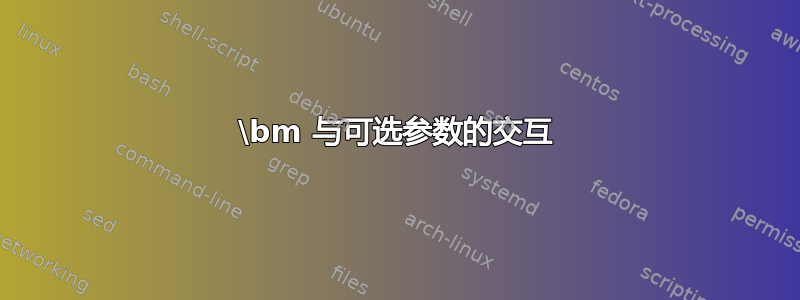
这里发生了什么?
\documentclass{article}
\usepackage{bm}
\newcommand{\myfuncA}[0]{A}
\newcommand{\myfuncB}[1]{#1}
\newcommand{\myfuncC}[1][]{#1}
\begin{document}
\[
\bm{\myfuncA} % works
\bm{\myfuncB{B}} % works
\textbf{\myfuncC[C]} % works
\bm{\myfuncC[C]} % doesn't work
\]
\end{document}
编辑1:overleaf 上的某个人是否愿意实施 David Carlilse 答案中的解决方案?
编辑2:有人告诉我这不太可能有用。没关系。
答案1
来自文档(texdoc bm):
3.5 奇怪的失败
为了获得正确的间距,
\bm必须“调查”其参数中命令的定义。某些奇怪的构造可能会“混淆”此调查。如果发生这种情况,LaTeX 几乎肯定会因奇怪的错误而停止。这不应该发生在基本 LaTeX 或 AMS 发行版中定义的任何数学符号上,或者使用普通 LaTeX 数学构造根据这些符号定义的任何命令上。但是,如果某个命令在内部不起作用,\bm您应该始终能够用一组额外的括号 \bm{{\cmd}} 而不是 \bm{\cmd} 将其括起来。 \bm 将不会尝试设置正确的间距,因此您可能需要明确设置它,例如对于关系,\bm{\mathrel{\cmd}}。
对于您的示例,将最后一行更改为
\bm{{\myfuncC[C]}}
使其编译。
答案2
这里发生了什么?
具体情况是这样的
% \changes{v1.1g}{2004/01/23}{Use kernel version of
% \cs{@ifnextchar} (pr/3501)}
\bm使得\@ifnextchar内部或多或少是安全的,\bm但是嗯“一段时间”\newcommand没有使用\@ifnextchar。
本地添加
\let\kernel@ifnextchar\@ifnextchar
所以它们都得到了安全产品
\documentclass{article}
\usepackage{bm}
\makeatletter
\let\bm@end\relax
\begingroup
\catcode`\'=\active
\catcode`\_=\active
\@firstofone{\endgroup
\def\bm@general#1#2#3#4#5{%
\begingroup
\let\bm\@firstofone
\let\hm\@firstofone
\global\let\bm@command\@empty
\let\@let@token\@empty
\let\protect\@empty
\let\@typeset@protect\@empty
\def\bm@mathchoice{\bm@m@thchoice#1}%
\def\bm@group{\bm@gr@up#1}%
\let\bm@table#2%
\let\left\holdinginserts
\let\right\left
\let\mskip\mkern
\let\hskip\kern
\let\bm@prime\copy
\let_\relax
\def'{\bm@prime\prime\relax}%
\def\@ifnextchar##1##2##3##4{%
\if##1##4%
\expandafter\@firstoftwo
\else
\expandafter\@secondoftwo
\fi
{##2##4}{##3{##4}}}%
% \changes{v1.1g}{2004/01/23}{Use kernel version of
% \cs{@ifnextchar} (pr/3501)}
\let\kernel@ifnextchar\@ifnextchar
\def\GenericWarning##1##2{%
\unvcopy{\GenericWarning{##1}{##2}}}%
\def\GenericError##1##2##3##4{%
\unvcopy{\GenericError{##1}{##2}{##3}{##4}}}%
\let\DN@\copy
\let\FN@\copy
\let\next@\copy
\global\let\bm@first\@empty
\ifx\uproot@\undefined\else
\def\root##1\of##2{{\root##1\of{##2}}}%
\fi
\def\mathaccentV##1{\mathaccent"\accentclass@}%
\let\@ifnext\@ifnextchar
\let\measure@lhs\copy
\let \rel@break\copy
\let \bin@break\copy
\let \after@open\copy
\let \after@close\copy
\let\ifmmode\iftrue
\let\install@mathalphabet\def
\let\getanddefine@fonts\@gobbletwo
#3%
\def\select@group##1##2##3##4{{%
\protect##1{##4}}}%
\def\use@mathgroup##1##2##3{{%
\protect\use@mathgroup##1{##2}{##3}}}%
\bm@expand#5\bm@end
\endgroup
#4}
}
\outer\def\bm@end{\@@end}
\makeatother
\newcommand{\myfuncA}[0]{A}
\newcommand{\myfuncB}[1]{#1}
\newcommand{\myfuncC}[1][]{#1}
\begin{document}
\[
\bm{\myfuncA} % works
\bm{\myfuncB{B}} % works
\textbf{\myfuncC[C]} % works
%\tracingall
\bm{\myfuncC[C]} % doesn't work
\]
\end{document}



